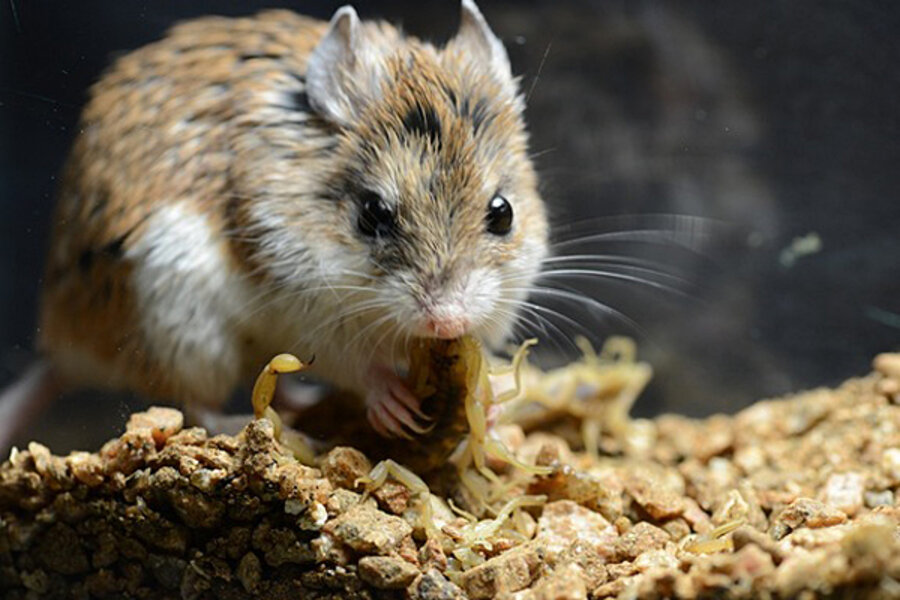How a mouse evolved to ignore a scorpion's sting
Loading...
The sting of the Arizona bark scorpion is so fierce that humans say the pain is like being hit by a hammer. But the tiny grasshopper mouse shakes off the sting like it's nothing.
Now, researchers have found for the mouse, the sting really is nothing. Instead of causing pain, the scorpion venom blocks it, a fact that could lead to the development of new pain-blocking drugs for people.
"The venom actually blocks the pain signal that the venom is trying to send" to the mouse, said study researcher Ashlee Rowe of Michigan State University. "We don't want to try to sound too cute or anything, but it is sort of like an evolutionary martial art, where the grasshopper mice are turning the tables. They're using their opponents' strength against them."
Fierce mouse
Southern grasshopper mice (Onychomys torridus) are carnivorous desert-dwellers. Among their favorite meals are the Arizona bark scorpions (Centruroides sculpturatus). The scorpions' sting would kill any other rodent the size of the grasshopper mouse, but the little rodent can absorb many stings in the course of attacking a scorpion. In studying this phenomenon, Rowe noticed not only did the mice survive, but they also seemed unconcerned. [See Video of a Mouse Attacking a Bark Scorpion]
"I was really intrigued by the fact that the mice, if they get stung, they just groom a little bit and then it's over," Rowe told LiveScience.
Clearly, the mice had evolved to handle the pain. To find out how, Rowe and her colleagues analyzed how the toxin acts on the nerve cells called nociceptors that pick up and relay pain to the mouse's brain.
Nerve cells communicate pain to the brain by translating stimuli into electric pulses. To do so, tiny channels in the cell membrane, called ion channels, open and close. One ubiquitous type of ion channel, the sodium/potassium channel, is present in cells throughout the body. This channel makes critical bodily functions, from breathing to muscle contractions, possible.
Typically, scorpion venom acts directly on sodium/potassium channels in nociceptors to create the sensation of pain. A specialized channel known as channel 1.7 is responsible for picking up the pain signal, whereas a channel called channel 1.8 carries it to the brain.
"They just turn [the nerve] on and send that signal to the brain," Rowe said.
Not so in the grasshopper mouse. In these rodents, the scorpion toxin binds to channel 1.8. [See Photos of the Amazing Grasshopper Mouse]
Cutting a wire
By binding to this transport channel, the toxin shuts it down, effectively blocking itself, Rowe and her colleagues report Friday (Oct. 25) in the journal Science.
"It's kind of like cutting a wire," Rowe said.
The finding explains why the mice seem to feel almost no pain when stung. Instead of acting as a painful stimulus, the toxin ends up acting like an analgesic.
Rowe thinks the grasshopper mice may be one of several animals that have evolved to withstand the scorpion's sting. She's currently investigating three possible creatures that might also feel no pain — though she prefers to keep the identities of those animals a secret until further testing. (Rowe won't be forcing scorpion showdowns in the name of this research; rather, she'll do genetic testing to look for signs of venom resistance.)
The ultimate goal of this work is to find new ways to ease pain in humans.
"One of the things we think is really important that's come out of this is to highlight the importance of sodium channel 1.8 and its ability to block pain signals," Rowe said. If scientists can figure out precisely how the toxin and the nerve cells interact, they may be able to produce compounds that mimic the venom's action. Such basic research also helps researchers understand how these crucial ion channels work
"These toxins do all kinds of interesting things to the channels," Rowe said. "They close them, they open them, they manipulate them in ways we can't imagine."
Follow Stephanie Pappas on Twitter and Google+. Follow us @livescience, Facebook & Google+. Original article onLiveScience.
Copyright 2013 LiveScience, a TechMediaNetwork company. All rights reserved. This material may not be published, broadcast, rewritten or redistributed.







